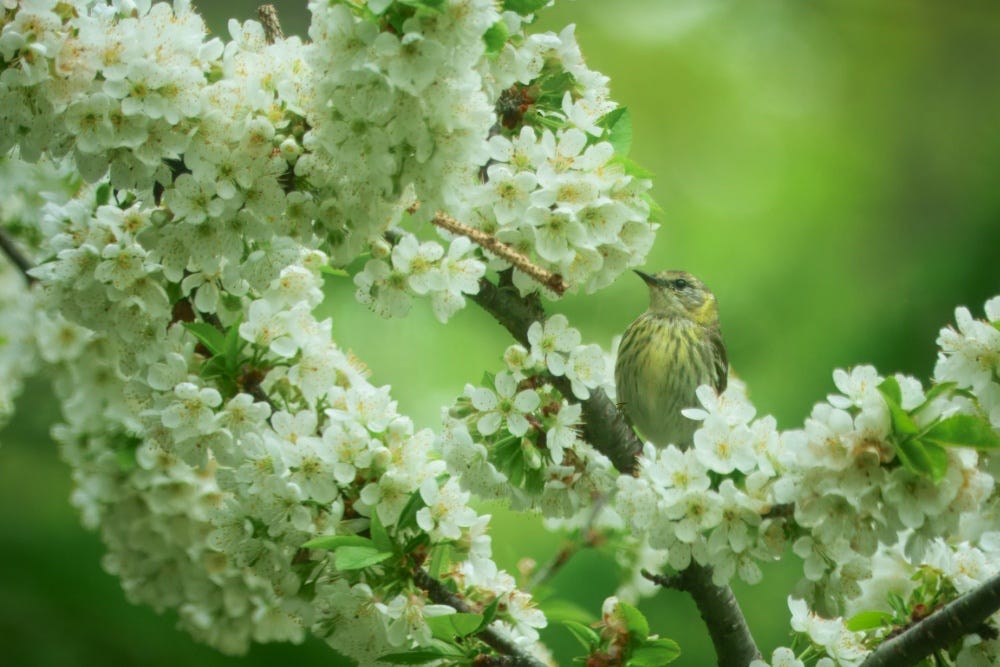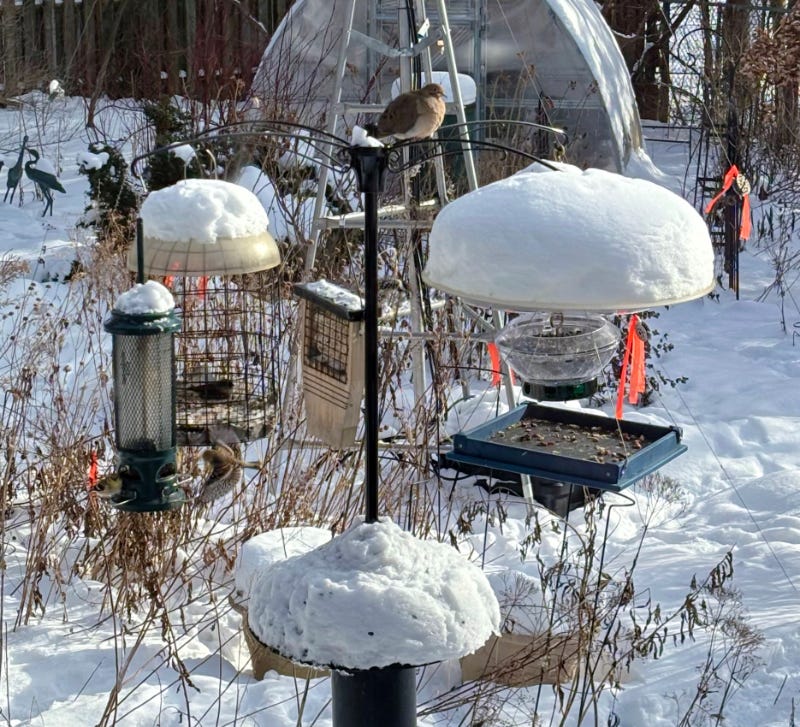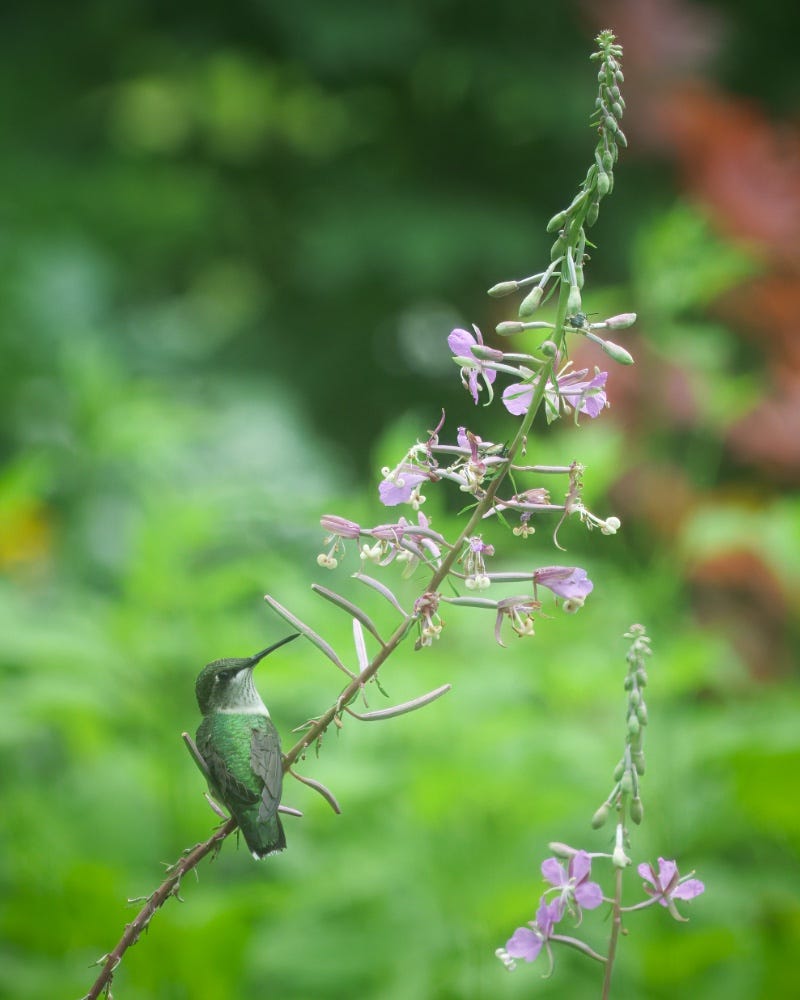Observations from the Window
The cold and snow and the relentless chill (I use that word ironically, this is Quebec) makes it a little harder to get up and go out walking. The windows frame a calm, wintry landscape, and offer the perfect excuse to settle down up with a warm drink and a good book. After all the birds may not be as easily encountered outside, as one would like and so, instead of walking, one could try to slow down, reflect, and find joy in life’s quieter moments.
This could make me feel guilty … BUT there is one productive thing that needs doing in early January and so all is not lost. You will have surmised that we keep an annual list of the number of birds we have seen in, or from (= flying over), the garden in each calendar year. It takes a couple of weeks to collate our notes, update eBird and agree on a definitive list but here we are - all that cold has created mental space to bring order to our records.
During 2024 a satisfying total of 75 bird species were recorded on our suburban garden list.
I’ll get to the detail shortly - but first … WHY do we keep lists? Good question, noting that it isn’t only birders who keep lists of species they have encountered, although a lister is more likely to be a birder than a botanist or entomologist. There are several reasons. For some it’s rather like train-spotting and for many it is a competitive sport with league tables and blogs aplenty. Some simply keep a low-level life list in a notebook while others set themselves challenges such as doing a Big Year (largest possible number of species seen in a year) or a Big Day for example. There are separate lists kept of species seen in the garden, in a town or county, state, province or country. Some people keep lists of birds seen or heard in television programmes or seen from their office window. The options are endless really and include the infamous Big Sit where the birder stays within a small circle, maybe just a few meters diameter, for a day and lists all the birds seen or heard from his or her seat … birds seen during ‘comfort breaks do not count. Finally there are green birding lists which are birds seen while walking or cycling from home with no recourse to a car/bus/train or plane. I do those, they are fun.
I can only speak for myself. I do have a life list but it will win no prizes. I do though, particularly enjoy keeping lists of birds seen on my “patch”. As well as an garden life-list, I/we keep an annual garden list, starting afresh each new year’s day. It’s good to be able to look back and see what’s new, which species have arrived in the course of a year and which are no longer being seen, even if they were regulars twenty years ago. I also do it because I am the sort of person who keeps lists of everything.
So - back to the 2024 garden list
We think that for any suburban garden in our sort of environment, seeing 75 or more distinct bird species in a calendar year is pretty good. I know people who have seen more - though they often have larger and more rural gardens or overlook fields or shoreline. Good luck to them. Our total garden life list - that’s from 1998 to this year is currently at 118 species. It once peaked at 120, but species lumps and splits knocked it back a little. We have only really kept intensive and reliable garden year lists since 2014 when we recorded 59 species, since when the trend has been upwards, peaking at 80 species during 2020.
It is commonly, and erroneously, believed that to see lots of exciting species you have to get your boots on and go out into “nature” somewhere the other end of a long car drive. Not so at all. Manage your garden so that it draws nature to you and allow the birds and bees to arrive, as they will. There is so much biodiversity to be found in our gardens and parks. Replacing that boring lawn with native plants, growing some bushes and installing a moving water feature will all help. Unless you are particularly favoured, you do have to put some effort into making your garden appealing to visiting and resident birds. In our case that means having trees and bushes and a log pile and lots of berry and seed bearing plants. It means having flowers that attract insects for birds to eat. In particular it means having no lawn and having a moderate sized garden pond with a waterfall. The waterfall is particularly important during spring and fall migration when passing birds are attracted by the sound of running water and drop in for a drink and a good splash around.
It is helpful to have strategically placed bird feeders with a variety of seeds and other food resources - this is one of our “cafés” with tube feeders holding sunflower seeds, platform feeders with a mixture of seeds including peanuts, a suet block, a platform feeder in a cage to keep bigger birds out and make life less stressful for the smaller chaps … and this year we added the “flying saucer” at the back which offers sunflower seed - always the most popular - in a different way. The Carolina Wrens, being basically ground feeders, love eating there where they can wade around in the seeds.
You are, at this point, perched on the edge of your seat muttering impatiently. “Tell us, tell us, just what birds visited. Stop prevaricating and get down to the meat and potatoes that we come here for” - and I do appreciate your urgent need to know.
People usually ask first about Warblers … and during 2024 we were visited by 16 different species. Most of them during spring migration and most of those at the waterfall. The species were:
Tennessee Warbler, Nashville Warbler, Mourning Warbler, American Redstart, Cape May Warbler, Northern Parula, Magnolia Warbler, Bay-breasted Warbler, Blackburnian Warbler, Yellow Warbler, Chestnut-sided Warbler, Blackpoll Warbler, Black-throated Blue Warbler, Yellow-rumped Warbler, Black-throated Green Warbler, Canada Warbler
I am especially fond of Sparrows … 6 species of those
Chipping Sparrow, American Tree Sparrow, Dark-eyed Junco, White-crowned Sparrow, White-throated Sparrow, Song Sparrow
Woodpeckers … 5 species
Yellow-bellied Sapsucker, Downy Woodpecker, Hairy Woodpecker, Pileated Woodpecker, Northern Flicker
Extra points were gained for several Ruby-throated Hummingbirds … they were with us for an extended period of time, attracted by a variety of flowers that we grow which they especially enjoy. Lobelia cardinalis, Monarda and a couple of pots of decidedly non-native but always appreciated Mexican cigar plants (Cuphea).
Raptors - the usual 3 species - Sharp-shinned Hawk, Cooper's Hawk, Merlin
Then there were our always welcomed Carolina Wrens - two of which were with us during the winter months at either end of the year (and are still here in January 2025, visiting daily) but mostly heard rather than seen during the warmer months. They have nested in the garden a couple of times, but not during 2024.
Corvids were represented by Blue Jay, American Crow, Common Raven and Thrushes by Veery, Swainson's Thrush, Hermit Thrush, American Robin
And then the rest … amongst which Thrasher, Rose-breasted Grosbeak, Indigo Bunting were worthy of special mention. Cardinals, American Goldfinch, House and Purple Finches, Turkey Vultures and a couple of Ducks flew overhead, A Great Blue Heron perched in a tree for a while, Chickadees, Kinglets, Nuthatches and Pine Siskins kept us interested.
Not bad at all for suburbia, very enjoyable and we are already busily listing the 2025 visitors.
Quebec Owls
I was sent this link to a video of the TEN species of Owls that may be seen in Quebec in winter.
Hats on Birds
I hope this link works for you (you never know when it comes from … teeny, tiny hats on birds. Some fun to start the day.
https://www.facebook.com/share/p/1BRN8ARdCv/












That's impressive. In the UK we have a citizen science thing called The Big Garden Bird Watch which happens at the end of January every year and everyone is encouraged to count the garden birds seen in a one hour period in their garden and report it to the RSPB. I've been doing it for years and it's a great project. Sadly, we can't feed the birds in our garden becasue we very quickly get rats!
Very interesting read by a birder from over the pond. Also keeping various lists.